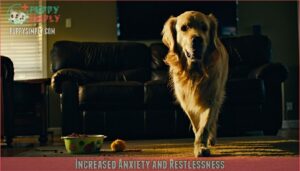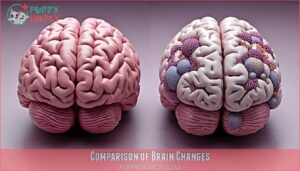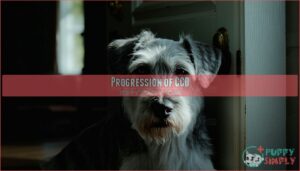This site is supported by our readers. We may earn a commission, at no cost to you, if you purchase through links.
 Deciding when to say goodbye to a dog with dementia is heart-wrenching, but their quality of life is your guide.
Deciding when to say goodbye to a dog with dementia is heart-wrenching, but their quality of life is your guide.
Look for signs like constant confusion, pacing, accidents, or extreme anxiety. If your dog seems lost in their own home or can’t enjoy food, play, or cuddles anymore, it may mean they’re suffering.
Assess their ability to do everyday things—like eating, walking, or recognizing loved ones. Trust your gut and consult your vet.
They’ll help you weigh emotional and practical factors. It’s never an easy call, but choosing peace for your pet can be the most selfless act of love.
Table Of Contents
- Key Takeaways
- Dog Dementia Signs
- Dementia Vs Alzheimer’s
- Managing Dog Dementia
- Euthanasia Considerations
- Progression of CCD
- Supporting a Dog With Dementia
- Making The Euthanasia Decision
- Frequently Asked Questions (FAQs)
- Should I euthanize my dog if it has dementia?
- What meat should I never feed my dog if they have dementia?
- Should you euthanize a dog?
- Why should a senior dog be euthanized?
- Should I euthanize my dog if he has cognitive dysfunction?
- What is dog dementia and when to put down the dog?
- How do you know when it’s time to put down a dog with dementia?
- What is the final stage of dog dementia?
- How do you calm a dog with dementia at night?
- How do I know when my dog has had enough?
- Conclusion
Key Takeaways
- Watch for signs like confusion, anxiety, accidents, or loss of interest in food and activities to assess your dog’s quality of life.
- Consult your vet to weigh emotional and practical factors when deciding on euthanasia.
- Prioritize your dog’s comfort and dignity over prolonging their suffering during advanced dementia stages.
- Trust your instincts and focus on their well-being when their daily struggles outweigh their joy.
Dog Dementia Signs
Recognizing the signs of dog dementia helps you understand your pet’s behavior and provide the right care.
Symptoms like confusion, accidents in the house, and changes in sleep or social habits can indicate your dog is struggling with cognitive decline.
Disorientation and Confusion
Disorientation and confusion in dog dementia can be heartbreaking to witness.
Watching your dog wander aimlessly, lost in familiar spaces, is a bittersweet reminder of their struggle with dementia.
Your dog might wander aimlessly, get stuck in corners, or seem lost in familiar spaces.
This loss of spatial awareness and cognitive mapping often comes with sensory overload, making environmental cues harder to process, and familiarity becomes critical.
When confusion disrupts daily life despite efforts, euthanasia may need consideration, as one potential cause is canine cognitive dysfunction, which should be diagnosed by a vet to determine the best course of action for your dog’s specific condition, considering canine health.
Changes in Sleep Patterns
Disturbed sleep patterns often follow the disorientation your dog experiences.
You’ll notice your furry friend pacing at night, struggling with restless sleep, or completely reversing their sleep-wake cycle.
Where they once slept soundly through the night, dogs with dementia may now sleep all day and remain active after dark.
These sleep disturbances can lead to altered activity levels and may worsen with progression of cognitive decline.
These changes can significantly impact your dog’s quality of life, and it’s essential to monitor their behavior and adjust their care accordingly to address the sleep disturbances.
Altered Interactions and Social Behavior
Your dog’s social interactions often change dramatically with dementia.
You might notice:
- Family aloofness or social withdrawal where they no longer greet you at the door
- Unexpected aggression changes toward familiar people or pets
- Clingy behavior or following you constantly
Recognition decline is common too.
Your once-social pup may suddenly treat family members like strangers or seem confused during regular interactions.
These altered interactions substantially impact your dog’s quality of life and may factor into end-of-life decisions.
Loss of House Training and Accidents
Why has your once perfectly house-trained dog suddenly started having accidents?
In canine cognitive dysfunction, loss of house training is common, and your pet may forget where to eliminate or become unable to signal their needs.
These accidents create hygiene concerns, infection risks, and surface damage beyond simple cleanliness impact, making managing incontinence and house soiling increasingly challenging as dog dementia progresses.
Sometimes, this factors into end-of-life decisions when quality of life diminishes, as the progression of dog dementia can significantly impact the well-being of the pet.
Increased Anxiety and Restlessness
As your dog’s dementia progresses, you’ll notice increased anxiety and restlessness becoming more prominent.
Increased anxiety and restlessness in dogs with dementia often signal advancing cognitive decline, deeply affecting their overall quality of life.
These behaviors substantially impact their quality of life and may indicate advancing cognitive decline.
- Pacing behavior often intensifies during evening hours (sundowning)
- Environmental changes like moving furniture can trigger panic attacks
- Constant whining or barking without apparent cause
- Inability to settle or relax despite calming techniques
- Decreased response to anxiety medication over time
Dementia Vs Alzheimer’s
You’ll notice similarities between canine cognitive dysfunction and human Alzheimer’s, as both conditions involve abnormal protein accumulation in the brain and cause memory loss, confusion, and behavioral changes.
While your dog’s dementia affects up to 68% of aging canines, the conditions differ in their progression rates and specific brain changes that occur during the disease process, involving abnormal protein accumulation.
Similarities in Symptoms
After noticing the strange behaviors in your aging dog, you might wonder how their condition compares to human dementia.
The symptoms of canine cognitive dysfunction mirror Alzheimer’s disease in remarkable ways.
Treatment with Vetoryl can help manage elevated cortisol levels in some dogs, though it isn’t a cure.
The following table highlights the parallels between human and animal cognitive decline:
| Human-Animal Parallels | Cognitive Decline | Behavioral Overlap |
|---|---|---|
| Memory impairment | Forgetting familiar faces | Forgetting learned commands |
| Disorientation | Getting lost in familiar places | Wandering aimlessly |
| Sleep disturbances | Day/night confusion | Reversed sleep cycles |
| Personality changes | Withdrawal from activities | Reduced interest in play |
| Anxiety/agitation | Restlessness | Increased pacing |
These similarities underscore the importance of understanding and addressing cognitive decline in aging dogs, to improve their quality of life and provide appropriate care.
Differences in Causes and Progression
The journey through cognitive decline differs markedly between canines and humans.
While both conditions share similarities, their causes and progression follow different paths.
Brain inflammation and degenerative changes occur in both conditions, but smaller dogs face higher risks due to longer lifespans.
| Factor | Dog Dementia | Human Alzheimer’s |
|---|---|---|
| Progression Rate | Much faster (months to 2 years) | Slower (years to decades) |
| Age of Onset | As early as 7-8 years | Typically 65+ years |
| Genetic Factors | Less understood | More extensively researched |
| Environmental Triggers | Less defined | More identified factors |
The key differences in progression rate, age of onset, genetic factors, and environmental triggers highlight the distinct nature of canine and human cognitive decline, with brain inflammation being a common factor.
Comparison of Brain Changes
Looking at the brain changes in dog dementia reveals striking similarities to human Alzheimer’s disease. Both conditions affect cognitive abilities through specific structural damage.
| Brain Feature | Dog Dementia | Human Alzheimer’s |
|---|---|---|
| Plaque Formation | Diffuse deposits | Concentrated plaques |
| Protein Accumulation | Beta-amyloid proteins | Similar but faster progression |
| Brain Atrophy | Selective shrinkage | Widespread tissue loss |
| Neurofibrillary Tangles | Less common | Primary feature |
Understanding these cellular changes helps inform euthanasia decisions when quality of life declines substantially, which is a critical aspect of managing dog dementia and ensuring the well-being of the animal, considering the impact on cognitive abilities and overall quality of life.
Managing Dog Dementia
You can improve your dog’s quality of life through proper management of canine cognitive dysfunction using a combination of dietary changes, mental exercises, and medication.
While there isn’t a cure for dog dementia, these strategies can substantially slow its progression and help maintain your pet’s comfort and dignity during this challenging time.
Nutritional Supplements and Diet
While understanding the differences between canine cognitive dysfunction and Alzheimer’s is important, proper nutrition can substantially impact your dog’s brain health.
Nutritional supplements offer powerful support for dogs with dementia:
- Antioxidants like vitamins E and C protect brain cells from damage
- Omega fatty acids (DHA and EPA) improve cognitive function at 35mg for small dogs, 70mg for large dogs
- Mitochondrial cofactors like alpha-lipoic acid help clear waste from brain cells
- Commercial supplements like Senilife and Activait provide thorough support
Consider MCT oil and diet adjustments as part of your dog dementia management plan. Many owners find success with specific supplement products.
Mental Stimulation and Exercise
Beyond supplementation, mental exercise is essential for dogs with dementia.
Regular social walks can create meaningful stimulation, while puzzle toys engage their problem-solving abilities.
Training games reinforce existing commands and provide quality of life improvements.
Incorporate sensory enrichment by introducing new smells and textures into routine activities.
Many owners find interactive treat dispensers helpful.
Research shows physically and mentally active dogs have a substantially lower risk of developing severe cognitive dysfunction, helping maintain their environmental enrichment capabilities longer, through environmental enrichment.
Prescribed Medications and Treatments
Veterinarians often prescribe medications to manage dog dementia symptoms and slow disease progression.
Selegiline hydrochloride (Anipryl) remains the only FDA-approved drug for canine cognitive dysfunction, enhancing brain dopamine levels and protecting nerve cells.
Other treatment options include:
- Anti-anxiety medications like trazodone or paroxetine when anxiety is a major factor
- Beta blockers such as propranolol as an affordable alternative
- Holistic therapies to complement prescribed medications
The goal of these treatments is to improve the dog’s quality of life by reducing symptoms and slowing the progression of the disease, with selegiline hydrochloride being a key component.
Euthanasia Considerations
You’ll face difficult decisions when your dog’s dementia reaches advanced stages that substantially impact their quality of life.
Making the choice about euthanasia requires careful assessment of your pet’s suffering, their ability to enjoy daily activities, and consultation with your veterinarian about the most compassionate path forward.
Quality of Life Assessment
Evaluating happiness and quality of life in a dog with dementia revolves around their daily function, cognitive decline, and physical comfort.
Monitor their ability to eat, move, and interact socially. One should also thoughtfully consider ways to prepare for euthanasia.
Use this table as a guide:
The key aspects to consider include cognitive decline, physical comfort, and the dog’s ability to engage in their daily routine in a predictable manner, as well as their level of social interaction.
Signs of Suffering and Distress
Restless pacing, severe anxiety, appetite decline, and vocalization changes can signal your dog’s distress.
Social withdrawal or confusion adds to their suffering. When addressing dog dementia quality of life, look for these signs to gauge their comfort.
Understanding when to euthanize a dog with dementia is a tough decision, but it’s rooted in easing their pain and prioritizing their well-being.
Emotional and Practical Factors
Deciding when to euthanize a dog with dementia involves emotional and practical factors.
Caregiver burden, timing concerns, and ethical considerations weigh heavily.
Financial implications and family impact also play a role.
Consider these questions:
- Is their quality of life declining?
- Are they suffering?
- Can you meet their needs?
- Is caregiving sustainable?
- What’s best for them emotionally?
Progression of CCD
As your dog ages, you might notice changes that signal the progression of canine cognitive dysfunction (CCD).
Understanding these stages helps you provide the best care while recognizing when they may need more support.
Early Stages and Symptoms
In the early stages, dog dementia signs can be subtle.
You might notice initial changes like confusion or slight memory lapses.
Your dog could forget routines or show minor behavioral shifts, like aimless wandering.
These early diagnosis moments often reflect cognitive decline setting in, which helps in recognizing dementia symptoms early and planning next steps for care, ultimately aiding in managing dog dementia behavior.
Middle Stages and Increased Decline
In the middle stages of dog dementia, cognitive worsening accelerates, leading to behavioral regression and physical decline.
You might notice your dog forgetting familiar faces, becoming disoriented in their home, or losing interest in activities.
This stage increases caregiver burden, making intervention timing and dementia management key.
Regular dog dementia quality of life assessments guarantee you’re addressing their changing needs compassionately.
Late Stages and End-of-Life Care
In the late stages of dog dementia, end-of-life care becomes essential.
Signs like severe disorientation, nighttime pacing, and constant confusion define this phase.
Hospice options focus on comfort measures and managing distress.
Evaluate quality of life carefully, balancing your dog’s needs with pet euthanasia considerations.
Consult your vet about legal aspects and aftercare choices for guidance, easing the grieving process.
Supporting a Dog With Dementia
Caring for a dog with dementia means adapting to their changing needs and providing them with a safe, supportive environment.
By maintaining routines and offering patience, you can help ease their confusion and keep their quality of life as high as possible, which is crucial for their overall well-being and requires a supportive environment.
Creating a Safe and Comfortable Environment
Creating a safe environment for a dog with dementia eases disorientation and anxiety.
Use these tips:
- Create Safe Zones: Block off dangerous areas and add soft bedding for comfort.
- Stick to Predictable Routines: Consistent feeding, walking, and sleeping schedules reduce confusion.
- Focus on Sensory Considerations: Keep lighting soft and add familiar scents to help them navigate and feel secure.
Some owners find it useful to create designated safe dog zones to help their dog feel secure.
Providing Emotional Support and Companionship
Spend time with your dog through bonding activities like gentle play or relaxing strolls.
Use affection techniques like soft petting to reduce isolation and provide comfort. Consistency in routines shows you care and keeps them calm.
These moments enhance their quality of life and offer deeper connection, easing your grief when facing end-of-life decisions like pet euthanasia considerations, which involve end-of-life care.
Managing Behavioral Changes and Accidents
Behavioral changes with dog dementia may feel overwhelming, but there are ways to help.
Try these steps:
- Use baby gates or crates for wandering prevention.
- Place washable pads to manage incontinence solutions.
- Offer calming scents or music for anxiety reduction.
- Stick to a schedule to ease sleep disruption.
Small adjustments can improve their quality of life, even amidst challenges, and help with wandering prevention.
Making The Euthanasia Decision
Deciding when to let go is one of the hardest choices you’ll ever face as a dog owner.
By focusing on your pet’s comfort and consulting with professionals, you can make a decision rooted in love and their well-being.
Evaluating Quality of Life and Suffering
Evaluating your dog’s quality of life focuses on their daily enjoyment and basic functions like eating, moving, and engaging meaningfully.
Persistent distress, anxiety, or struggles from cognitive decline may signal it’s time for euthanasia.
Evaluate their comfort using a dog quality of life assessment table like this:
| Key Aspect | Good Days | Bad Days | Notes |
|---|---|---|---|
| Sleep Patterns | |||
| Appetite | |||
| Interaction Level | |||
| Pain or Anxiety |
Consulting With Veterinarians and Experts
Veterinary advice plays a key role when deciding when to euthanize a dog with dementia.
Experts provide insight into the diagnostic process, treatment options, and ethical considerations.
Regular evaluations guarantee no other conditions mimic dementia. Don’t hesitate to seek second opinions when unsure.
Trust veterinary care to guide these end-of-life decisions, keeping your pet’s comfort and dignity at heart.
Coping With Guilt and Grief After Euthanasia
Losing a pet after euthanasia brings waves of guilt and grief.
It’s normal to question your decision, but remember it was an act of love.
Seek guilt management and grief resources. Memorializing pets helps honor their memory.
Lean on support systems like friends or pet owner groups. Understanding the process can offer closure, so consider understanding the procedure.
Grieving pet loss takes time—allow yourself to heal while finding peace in cherished moments.
Frequently Asked Questions (FAQs)
Should I euthanize my dog if it has dementia?
Deciding depends on quality of life.
If confusion, distress, or disorientation dominate daily life, and your dog no longer enjoys activities or bonds with you, it’s time to compassionately prioritize their comfort and consult your vet.
What meat should I never feed my dog if they have dementia?
Avoid feeding your dog processed meats like bacon, sausage, or deli slices.
They’re high in sodium and additives, which can worsen brain health.
Stick to lean, unseasoned meats like chicken or turkey for better cognitive support.
Should you euthanize a dog?
When a candle flickers more than it shines, it’s time to reevaluate its flame.
Deciding to euthanize a dog revolves around their comfort, dignity, and life quality.
Trust your veterinarian and your heart’s intuition.
Why should a senior dog be euthanized?
A senior dog should be euthanized when their quality of life declines substantially—persistent confusion, distress, or inability to enjoy daily activities.
It’s a compassionate choice to prevent prolonged suffering and honor their dignity.
Should I euthanize my dog if he has cognitive dysfunction?
When your dog’s world feels like a fading photograph, focus on their quality of life.
If confusion, distress, or lost joy dominates their days, consult your vet to guarantee their comfort and dignity.
What is dog dementia and when to put down the dog?
Dog dementia, or CCD, affects aging dogs with symptoms like confusion, anxiety, and disorientation.
Consider euthanasia when your dog’s quality of life declines substantially—consult your vet to guarantee a compassionate, well-informed decision prioritizing their comfort.
How do you know when it’s time to put down a dog with dementia?
You’ll know it’s time when your dog’s quality of life diminishes—confusion, distress, or inability to enjoy daily activities.
Consult your vet, trust your instincts, and prioritize their comfort over prolonging suffering.
What is the final stage of dog dementia?
The final stage of dementia includes severe disorientation, inability to recognize loved ones, frequent accidents, extreme anxiety, and loss of basic functions like eating or walking.
It’s heartbreaking, but your dog’s comfort becomes the priority, focusing on their basic needs like eating or walking is no longer possible.
How do you calm a dog with dementia at night?
Try soothing their anxiety with a consistent nighttime routine, dim lighting, and white noise.
Add calming aids like a pheromone diffuser or melatonin, and keep their sleeping area familiar and cozy to reduce discomfort.
How do I know when my dog has had enough?
Ever wonder if your dog’s struggles outweigh their joy?
Watch for constant confusion, distress, or loss of interest in life.
If they’re no longer themselves, it might be time to prioritize their peace over prolonging pain.
Conclusion
Deciding when to euthanize a dog with dementia demands deep dedication and difficult decisions.
Watch for worsening confusion, constant anxiety, or an inability to enjoy life’s basics.
Your dog’s quality of life should guide you—if they’re suffering, it’s time to ponder peace.
Consult your vet, trust your instincts, and remember this choice reflects your love.
Though it’s heartbreaking, letting go can bring relief to your pet and honor the bond you’ve shared.
- https://www.animalhealthfoundation.org/blog/2020/02/dementia-in-dogs-cognitive-dysfuntion-syndrome/
- https://digital.lib.washington.edu/researchworks/handle/1773/47530
- https://staroftexasvet.com/wp-content/uploads/2023/01/Canine-Cognitive-Dysfunction-Scale.pdf
- https://www.vet.cornell.edu/departments-centers-and-institutes/riney-canine-health-center/canine-health-information/cognitive-dysfunction-syndrome
- https://vcahospitals.com/know-your-pet/nutrition-for-dogs-with-cognitive-dysfunction-syndrome-cds



















